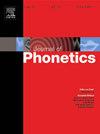Investigating interlanguages beyond categorical analyses: Prosodic marking of information status in Italian learners of German
IF 2.4
1区 文学
0 LANGUAGE & LINGUISTICS
引用次数: 0
Abstract
Previous studies report that Italian learners of German transfer their L1 prosody to their L2 when marking information status prosodically within noun phrases (NPs). However, these studies were based on a categorical analysis of accentuation based on the presence or absence of pitch accents, which might not provide the full picture of interlanguages, in which category boundaries are flexible and dynamically evolving. We elicited two-word NPs in two different information status conditions – given-new (GN) and new-given (NG) – in L1 German, L1 Italian, and L2 German. We performed a periodic-energy-informed analysis to explore speakers’ continuous modulation of F0 and prosodic strength and additionally discuss the results for the interlanguage in categorical terms. Learners prosodically mark information status by modulating the F0 contour on the first word similarly to their L1. However, learners reduce the prosodic strength of the second word in the noun phrase across the board, i.e. irrespective of information status. This pattern resembles German deaccentuation, and indicates that the learners are using a salient pattern but are not associating it with the appropriate pragmatic function. The current study revealed patterns for L1 Italian learners of L2 German which did not emerge in previous categorical analyses of the intonation of Italian learners of German.
超越范畴分析的中介语研究:义大利德语学习者信息状态的韵律标记
先前的研究表明,意大利德语学习者在名词短语(NPs)中标记信息状态时,会将他们的母语韵律转移到第二语言。然而,这些研究都是基于对音高是否存在的重音的分类分析,这可能无法提供中介语的全貌,因为中介语的类别边界是灵活和动态发展的。我们在L1德语、L1意大利语和L2德语的两种不同的信息状态条件下——给定新(GN)和新给定(NG)引出了两个单词的np。我们进行了周期性能量分析,以探索说话者对F0和韵律强度的连续调制,并从分类角度讨论了中介语的结果。学习者通过调节第一个单词的F0等高线来节律性地标记信息状态,这与他们的L1相似。然而,学习者普遍降低名词短语中第二个单词的韵律强度,即不考虑信息状态。这种模式类似于德语的去重音,表明学习者正在使用一个突出的模式,但没有将其与适当的语用功能联系起来。目前的研究揭示了母语意大利语学习者对第二语言德语的语调模式,这在之前对意大利语学习者对德语的语调进行的分类分析中没有出现。
本文章由计算机程序翻译,如有差异,请以英文原文为准。
求助全文
约1分钟内获得全文
求助全文
来源期刊

Journal of Phonetics
Multiple-
CiteScore
3.50
自引率
26.30%
发文量
49
期刊介绍:
The Journal of Phonetics publishes papers of an experimental or theoretical nature that deal with phonetic aspects of language and linguistic communication processes. Papers dealing with technological and/or pathological topics, or papers of an interdisciplinary nature are also suitable, provided that linguistic-phonetic principles underlie the work reported. Regular articles, review articles, and letters to the editor are published. Themed issues are also published, devoted entirely to a specific subject of interest within the field of phonetics.
 求助内容:
求助内容: 应助结果提醒方式:
应助结果提醒方式:


